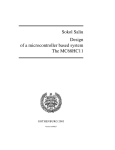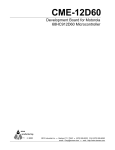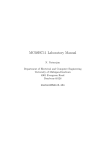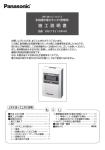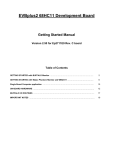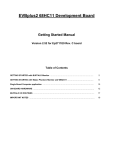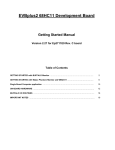Download Motorola CME-12D60 User manual
Transcript
Monitor12 (MON12) User Manual
05/30/01
CONTENTS
START-UP ................................................................................................................................................................ 2
MONITOR PROGRAM ............................................................................................................................................. 2
INTRODUCTION .................................................................................................................................................. 2
INITIALIZATION ................................................................................................................................................. 3
COMMAND INTERPRETER ................................................................................................................................ 3
I/O ROUTINES...................................................................................................................................................... 4
UTILITY SUBROUTINES..................................................................................................................................... 4
COMMAND TABLE ............................................................................................................................................. 6
INTERRUPT VECTORS........................................................................................................................................ 6
INTERRUPT VECTOR RAM TABLE ............................................................................................................... 7
OPERATING INSTRUCTIONS................................................................................................................................. 8
INTRODUCTION .................................................................................................................................................. 8
RESET SWITCH................................................................................................................................................ 8
LIMITATIONS .................................................................................................................................................. 8
OPERATING PROCEDURES................................................................................................................................ 8
DEBUGGING MODE ........................................................................................................................................ 8
EVALUATION MODE ...................................................................................................................................... 9
MONITOR PROGRAM ......................................................................................................................................... 9
COMMAND LINE FORMAT ............................................................................................................................ 9
MONITOR COMMANDS ........................................................................................................................................10
COMMAND TABLE ............................................................................................................................................11
MONITOR COMMAND DESCRIPTIONS ...........................................................................................................12
BF
- BLOCK FILL MEMORY....................................................................................................................12
BR
- BREAKPOINT SET or CLEAR .........................................................................................................12
BULK
- BULK ERASE EEPROM................................................................................................................14
CALL
- EXECUTE SUBROUTINE .............................................................................................................14
GO
- GO EXECUTE PROGRAM ................................................................................................................15
? / HELP - DISPLAY MENU.........................................................................................................................15
LOAD - RECEIVE S-RECORD FILE...........................................................................................................16
MD
- MEMORY DISPLAY ........................................................................................................................16
MM - MEMORY MODIFY ..........................................................................................................................17
MOVE - MOVE MEMORY CONTENTS......................................................................................................18
P
- PROCEED FROM BREAKPOINT .........................................................................................................18
RD
- REGISTER DISPLAY ........................................................................................................................19
RM
- REGISTER MODIFY .........................................................................................................................19
T - TRACE ...................................................................................................................................................20
TM
- TRANSPARENT MODE ....................................................................................................................20
VERIFY - VERIFY MEMORY AGAINST S RECORD ................................................................................21
DOWNLOADING PROCEDURES...........................................................................................................................22
APPENDIX A: S-RECORD INFORMATION.........................................................................................................23
1
Monitor12 (MON12) User Manual
05/30/01
START-UP
Applying power to the EVB causes a Power On Reset (POR) to occur. This POR
condition causes the MCU and user I/O port circuitry to be reset, and the
monitor invoked. Board COM1 port will display the monitor prompt at 9600 baud,
8,n,1:
AXIOM MANUFACTURING CME12D60, PRESS KEY TO START MONITOR…
At this state the monitor is waiting to start or launch board support utilities.
User should press any alphanumeric key on the terminal keyboard to launch the
debug monitor. The debug monitor prompt will display similar text:
Axiom MON12 – HC12 Monitor / Debugger Vxx.x
Type “Help” for commands…
>
If the EVB monitor prompt is not displayed (as shown above), press the user
reset switch on the board. If the EVB monitor prompt cannot be displayed, the
following steps are to be performed.
a.
Disconnect EVB power source.
b.
Check all EVB cabling and power connections.
c. Check hardware options, configuration switches, and preparation
procedures. Verify HC12 mode of operation (Expanded).
d.
Check all EVB components for proper PCB placement.
e. Check PC baud rate and terminal software setup for 9600 baud, 8 bits, 1
stop, no parity.
MONITOR PROGRAM
INTRODUCTION
This chapter provides the overall description of the monitor program.
This
description will enable the user to understand the basic structure of the
program. This program is ported from the Motorola BUFFALO monitor.
2
Monitor12 (MON12) User Manual
05/30/01
PROGRAM DESCRIPTION
The monitor program supplied for the EVB is called MON12.
This program is
firmware based and communicates via the HC12 Serial Communications Interface
(SCI0) port. User must be aware that the monitor will initialize the hardware to
operate this port and that user programs can override proper operation of the
port to support the monitor. The monitor uses polling methods to determine port
status so interrupt operation with the SCI port would cause an interference with
the monitor.
The monitor program is contained in EPROM (external to the MCU). Having the
monitor program in EPROM external to the MCU at locations $COOO-$FFFF is a great
advantage because it allows the user to add instructions to customize the
monitor for specific requirements.
The main module of the monitor program includes all the parts required by any of
the individual command modules. Therefore the main module is a kernel of the
BUFFALO monitor program, and consists of five parts which are as follows:
a.
Initialization
b.
Command interpreter
c.
I/O routines
d.
Utility subroutines
e.
Command table
INITIALIZATION
This part of the main module contains all of the reset initialization code. In
this section, internal RAM locations are set up, and the I/O channels for the
terminal is set up. The monitor will adjust the memory map of the HC12 device
for maximum use. The HC12D60 version of the monitor moves the Register space
from the Reset default address of $0000 to $0800 hex and disables the internal
Flash memories. This provides maximum user memory space in external ram memory
for debugging.
COMMAND INTERPRETER
The next section of the main module is the command interpreter. American
Standard Code for Information Interchange (ASCII) characters are read from the
terminal into the input buffer until a carriage return or a slash (/) is
received. The command field is then parsed out of the input buffer and placed
into the command buffer. A table of commands is then searched and if a match is
found, the corresponding command module is called as a subroutine. All commands
return back to the command interpreter upon completion of the operation.
3
Monitor12 (MON12) User Manual
05/30/01
I/O ROUTINES
The I/O section of the main module consists of a set of supervisor routines, and
three sets of driver routines.
The supervisor routines are INIT, INPUT, and
OUTPUT. These routines determine which driver subroutine to call to perform the
specific action.
Each set of driver routines consists of an initialization
routine, an input routine, and an output routine. One set of drivers is for the
SCI port and these routines are called ONSCI, INSCI, and OUTSCI.
All I/O communications are controlled by three RAM locations (IODEV, EXTDEV, and
HOSTDEV). EXTDEV specifies the external device type (0=none, l=SCI1). HOSTDEV
specifies which I/O port is used for host communications (O=SCI, 1=SCI1). IODEV
instructs the supervisor routine which port/driver routine to use (0=SCI,
1=SCI1).
The INIT routines set up a serial transmission format of eight data bits, two
stop bits, and no parity. For the SCI, the baud rate is set to 9600 for a 16MHz
crystal (8MHz E-clock). To achieve a different baud rate the baud rate control
registers can be modified using the MM command.
For the SCI, this means
modifying the SCOBDH and SCOBDL registers (refer to MCU data sheet, SCI baud
rate selection).
The INPUT routine reads from the specified port. If a Character is received,
the character is returned in accumulator A. If no character is received a zero
(0) is returned in accumulator A. This routine does not wait for a character to
be received before returning (this function performed by the INCHAR subroutine).
The OUTPUT routine takes the ASCII character loaded in accumulator A and writes
to the specified I/O port.
This routine waits until the character is
transmitted before returning.
UTILITY SUBROUTINES
Several subroutines exist that are available for performing I/O tasks. A jump
table has been set up in ROM directly beneath the interrupt vectors.
To use
these subroutines, execute a jump to subroutine (JSR) command to the appropriate
entry in the jump table. By default, all I/O performed with these routines is
sent to the terminal port. Redirection of the I/O port is achieved by placing
the specified value (O=SCI, 1=SCI1) into RAM location IODEV.
Utility subroutines available to the user are as follows:
UPCASE
If character in accumulator A is lower case alpha, convert to upper
case.
WCHEK
Test character in accumulator A and return with Z bit set if
character is white space (space, comma, tab).
DCHEK
Test character in accumulator A and return with Z bit set if
character is delimiter (carriage return or white space).
INIT
Initialize I/O device.
INPUT
Read I/O device.
OUTPUT
Write I/O device.
4
Monitor12 (MON12) User Manual
05/30/01
OUTLHLF
Convert left nibble of accumulator ‘A’ contents to ASCII and output
to terminal port.
OUTRHLF
Convert right nibble of accumulator ‘A’ contents to ASCII and output
to terminal port.
OUTA
Output accumulator A ASCII character.
OUTlBYT
Convert binary byte at address in index register X to two ASCII
characters and output. Returns address in index register X pointing
to next byte.
OUTlBSP
Convert binary byte at address in index register X to two ASCII
characters and output followed by a space. Returns address in index
register.
OUT2BSP
Convert two consecutive binary bytes starting address in index
register X to four ASCII characters and output followed by a space.
Returns address in index register X pointing to next byte.
OUTCRLF
Output ASCII carriage return followed by a line feed.
OUTSTRG
Output string of ASCII bytes pointed to by address in index register
X until character is an end of transmission ($04).
OUTSTRGO
Same as OUTSTRG except leading carriage return and line feed is
skipped.
INCHAR
Input ASCII character to accumulator A and echo back.
loops until character is actually received.
This routine
Utility jump subroutines for performing I/O tasks are shown below.
These
subroutines are in ROM and are programmed as jumps. To use the jump subroutine,
execute a JSR to the applicable address shown below.
$FFAO
$FFA3
$FFA6
$FFA9
$FFAC
$FFAF
$FFB2
$FFB5
$FFB8
$FFBB
JMP
JMP
JMP
JMP
JMP
JMP
JMP
JMP
JMP
JMP
UPCASE
WCHEK
DCHEK
INIT
INPUT
OUTPUT
OUTLHLF
OUTRHLF
OUTA
OUTlBYT
$FFBE
JMP
OUT1BSP
$FFCl
JMP
OUT2BSP
$FFC4
$FFC7
JMP
JMP
OUTCRLF
OUTSTRG
$FFCA
JMP
OUTSTRGO
$FFCD
JMP
INCHAR
Convert character to uppercase
Test character for whitespace
Check character for delimiter
Initialize I/O device
Read I/O device
Write I/O device
Convert left nibble to ASCII and output
Convert right nibble to ASCII and output
Output ASCII character
Convert binary byte to 2 ASCII characters and
output
Convert binary byte to 2 ASCII characters and
output followed by space
Convert 2 consecutive binary bytes to 4 ASCII
characters and output followed by space.
Output ASCII carriage return followed by line feed
Output ASCII string until end of transmission
(EOT / $04)
Same as OUTSTRG except leading carriage return and
line feed is skipped
Input ASCII character and echo back
5
Monitor12 (MON12) User Manual
05/30/01
COMMAND TABLE
The command table consists of three lines for each entry. The first byte is the
number of characters in the command name. The second entry is the ASCII command
name. The third entry is the starting address of the command module. As and
example:
FCB
FCC
FDB
2
'MM'
#MEMORY
2 characters in command name
ASCII literal command name string
Jump address for command module
Each command in the Monitor program is a individual module. Thus, to add or
delete commands, all that is required is to include a new command table.
INTERRUPT VECTORS
Interrupt vectors reside in Monitor Program memory and are accessible as pseudo
vectors in a ram based look-up table. Each vector is assigned a two byte field
residing in HC12 internal Ram. The Ram table may be relocated for different
types of HC12 devices so that it remains in internal ram. Each pseudo vector
operates similar to the firmware interrupt vectors, the pseudo vector contents
are the memory address of the interrupt service routine. An interrupt service
can be located anywhere in the 64K byte address map by the user except at
address $0000. If an interrupt occurs for an empty vector, it will be trapped by
the monitor. The monitor trap service will provide the vector offset number for
the trapped interrupt. This number represents the pseudo vector location in the
Ram table. To recover from a trapped interrupt, the EVB board must be Reset.
The following Table lists the pseudo and associated hardware interrupt vectors:
Ram Table base address for the HC12D60 = $600.
6
Monitor12 (MON12) User Manual
05/30/01
INTERRUPT VECTOR RAM TABLE
Pseudo Vector Number
Or Table Offset
00
02
04
06
08
0A
0C
0E
10
12
14
16
18
1A
1C
1E
20
22
24
26
28
2A
2C
2E
30
32
34
36
38
3A
3C
3E
HC12 INTERRUPT VECTOR
$FFC0
$FFC2
$FFC4
$FFC6
$FFC8
$FFCA
$FFCC
$FFCE
$FFD0
$FFD2
$FFD4
$FFD6
$FFD8
$FFDA
$FFDC
$FFDE
$FFE0
$FFE2
$FFE4
$FFE6
$FFE8
$FFEA
$FFEC
$FFEE
$FFF0
$FFF2
$FFF4
$FFF6
$FFF8
$FFFA
$FFFC
$FFFE
Vector ID
UNUSED VECTOR
PLL/ CGM LOCK
MSCAN TX
MSCAN RX
MSCAN ERROR
PULSE ACC. B OVERFLOW
MODULUS COUNTER
PORT G/H KEY WAKE-UP
MSCAN WAKE-UP
ADC 0/1
SCI 1
SCI 0
SPI
PULSE ACC. A INPUT
PULSE ACC. A OVERFLOW
TIMER OVERFLOW
TIMER 7
TIMER 6
TIMER 5
TIMER 4
TIMER 3
TIMER 2
TIMER 1
TIMER 0
RTI
IRQ
XIRQ
SWI
TRAP
COP
CLM
RESET, Not available to user.
To use vectors specified in the table, the user must insert the address of the
interrupt service routine during code initialization into the pseudo interrupt
table. For an example, for the IRQ vector, the following is performed:
Example:
IRQ Service routine label = IRQ_SRV
Ram Vector Table address is defined – RIV_TBL EQU $600
Place IRQ service routine address in the table –
MOVW
#IRQ_SRV,RIV_TBL+$32
After debug and the user application is to be programmed for stand alone
operation without the Monitor, the actual interrupt vector table should be added
and the ram vector table loading deleted.
7
Monitor12 (MON12) User Manual
05/30/01
OPERATING INSTRUCTIONS
INTRODUCTION
This chapter provides the necessary information to initialize and operate the
EVB in a target system environment. Information consists of the control switch
description, operating limitations, command line format, monitor commands, and
operating procedures. The operating procedures consist of assembly/disassembly
and downloading descriptions and examples.
RESET SWITCH
The EVB provides a user reset switch. This switch is a momentary action pushbutton switch that resets the EVB MCU circuits. Momentary pressing of the switch
will cause the Monitor to restart and the EVB to be re-initialized.
LIMITATIONS
The MCU SCI has been set for 9600 baud using an 8MHz E clock external bus. This
baud rate can be changed by software by re-programming the SC0BDL register in
the ONSCI subroutine of the monitor program.
The RS-232C handshake lines are not used on the COM1 SCI port. A delay of
approximately 100 milliseconds is present between successive characters sent to
terminal computer during the execution of the LOAD command in the monitor
program.
The monitor program will use a portion of the MCU internal RAM resources and may
move internal memory or registers to provide the most complete memory map for
operation. See the EVB board manual for memory mapping details and memory use.
Monitor operation typically requires the external bus to be enabled on the MCU
(Expanded Mode). The MCU external bus requires I/O port use of at least two
ports (16 bits) and some control lines. The MCU expanded bus ports cannot be
applied by the user for I/O functions.
OPERATING PROCEDURES
The EVB is a simplified debugging/evaluating tool designed to operate in either
the debugging or evaluation (emulation) mode of operation.
DEBUGGING MODE
The first mode of operation allows the user to debug user code under control of
the monitor program.
User code assembled or compiled on a host computer is
downloaded to the EVB user RAM (see EVB manual for Ram memory location) in
Motorola S-record format (LOAD command). The monitor program is then used to
debug the assembled user code by the use of Breakpoint and Trace command
operations to isolate any code errors.
Having the monitor program in EPROM
external to the MCU ($C000-$FFFF) allows the user to add instructions to
customize the monitor for specific requirements.
8
Monitor12 (MON12) User Manual
05/30/01
EVALUATION MODE
The second mode of operation allows the user to evaluate (emulate) user code in
a target system environment utilizing the memory of the MC68HC912 MCU. This is
accomplished by relocating the code from RAM memory locations (EVB user RAM) to
MCU programmable memory locations (Typically $8000 - $FFFF, see MCU user
manual). The MCU internal ram and EEprom are also available to the user in this
mode.
The EVB then operates the user application in the single chip mode of
operation or in expanded mode from the EVB boards program memory area.
MONITOR PROGRAM
The monitor program is the resident firmware for the EVB, which provides a self
contained operating environment.
The monitor interacts with the user through
predefined commands that are entered from a terminal. The user can use any of
the commands supported by the monitor.
A standard input routine controls the EVB operation while the user types a
command line.
Command processing will begin only after the command line has
been terminated by depressing the keyboard carriage return (Return or Enter)
key.
COMMAND LINE FORMAT
The command line format is as follows:
>[command] [<parameters>](<ENTER)
where:
>
EVB monitor prompt or cursor.
command
Command mnemonic(single letter for most commands).
<parameters>
Expression or address, maybe optional.
(<ENTER)
ENTER or RETURN keyboard key - depressed to enter
command.
NOTES:
(1) The command line format is defined using special characters which have the
following syntactical meanings:
[ ]
Enclose optional fields, note that last command will be repeated if
a new command is not entered.
< >
Enclose syntactical variable
[ ]... Enclose optional fields repeated
These characters are not entered by the user, but are for definition purposes
only.
(2) Fields are separated by any number space, comma, or tab characters.
(3) All input numbers are interpreted as hexadecimal.
9
Monitor12 (MON12) User Manual
05/30/01
(4) All input commands can be entered either upper or lower case lettering. All
input commands are converted automatically to upper case lettering except for
downloading commands sent to the host computer, or when operating in the
transparent mode.
(5) A maximum of 35 characters may be entered on a command line. After the 36th
character is entered, the monitor automatically terminates the command entry and
the terminal CRT displays the message "Too Long".
(6) Command line errors may be corrected by backspacing (CTRL-H) or by aborting
the command (CTRL-X or DELETE).
(7) After a command has been entered, pressing (RETURN) a second time will
repeat the command.
MONITOR COMMANDS
The monitor BUFFALO program commands are listed alphabetically by mnemonic in
Table 1. Each of the commands are described in detail following the tabular
command listing.
Additional terminal keyboard functions are as follows:
(CTRL)A
Exit transparent mode or assembler
(CTRL)B
Send break command to host in transparent mode
(CTRL)H
Backspace
(CTRL)J
Line feed <1f>
(CTRL)W
Wait/freeze screen (Note 1)
(DELETE)
Abort/cancel command
(RETURN)
Enter command/repeat last command
NOTES:
(1) Execution is restarted by any terminal keyboard key.
(2) When using the control key with a specialized command such as (CTRL)A, the
(CTRL) key is depressed and held, then the A key is depressed. Both keys are
then released.
Command line input examples in this chapter are amplified with the
following:
Underscore entries are user-entered on the terminal keyboard.
Command line input is entered when the keyboard (RETURN) key is depressed.
Typical example of this explanation is as follows:
>MD F000 F100
10
Monitor12 (MON12) User Manual
05/30/01
COMMAND TABLE
COMMAND
DESCRIPTION
BF <addr1> <addr2> <data>
Block fill memory with data
BR [-] [<address>]...
Breakpoint set or clear
BULK
Bulk erase EEPROM
CALL [<address>]
Execute subroutine
G [<address>]
Execute program
HELP or ?
Display monitor commands
LOAD
Download (S-records*) via terminal port
MD [<addr1>] [<addr2>]
Dump memory to terminal
MM [<address>]
Memory modify
MOVE <addr1> <addr2> [<destination>] Move memory to new location
P
Proceed/continue from breakpoint
RM [p,y,x,a,b,c,s,]
Register modify
T [<n>]
Trace $1-$FF instructions
TM
Enter transparent mode
VERIFY
Compare memory to download data (S record)
NOTE: * Refer to Appendix A for S-record information.
11
Monitor12 (MON12) User Manual
05/30/01
MONITOR COMMAND DESCRIPTIONS
BF
-
BLOCK FILL MEMORY
BF <address1> <address2> <data>
where:
<address1>
Lower limit for fill operation.
<address2>
Upper limit for fill operation.
<data>
Fill pattern hexadecimal value.
The BF command allows the user to repeat a specific byte throughout a memory
range. If an invalid address is specified, an invalid address message "rom-xxxx"
is displayed. (xxxx = invalid address).
EXAMPLES
DESCRIPTION
>BF 0200 0230 FF
Fill each byte of memory from 0200 through 0230 with
data pattern FF.
>BF 0200 0200 0
Set location 0200 to 0.
BR
-
(Use MM command also)
BREAKPOINT SET or CLEAR
BR [-][<address>]...
where:
[<address>] by itself sets a breakpoint at this address.
[-] by itself removes (clears) all breakpoints.
[-] proceeding [<address.]... removes individual or multiple addresses
from breakpoint table.
The BR command sets the address into the breakpoint address table. During
program execution, a halt occurs to the program execution immediately preceding
the execution of any instruction address in the breakpoint table. A maximum of
four breakpoints may be set. After setting the breakpoint, the current
breakpoint addresses, if any, are displayed. Whenever the G, CALL, or P
commands are invoked, the monitor program inserts breakpoints into the user code
at the addresses specified in the breakpoint table.
Breakpoints are accomplished by the placement of a software interrupt (SWI) at
each address specified in the breakpoint address table. The SWI service routine
saves and displays the internal machine state, then restores the original
instructions at the breakpoint location before returning control back to the
monitor program.
12
Monitor12 (MON12) User Manual
05/30/01
The SWI instruction cannot be executed in user code because the monitor program
uses the SWI vector. Breakpoints can only be used in RAM memory locations.
NOTE:
Breakpoints should not be set on branch, jump, JSR, or test and branch
instructions. Setting a breakpoint on these types of instructions may prevent
the Proceed command from operating correctly.
COMMAND FORMATS
DESCRIPTION
BR
Display all current breakpoints.
BR <address>
Set breakpoint.
BR <addr1> <addr2>...
Set several breakpoints.
BR -
Remove all breakpoints.
BR -<addr1> <addr2>...
Remove <addr1> and add <addr2>.
BR <addr1> - <addr2>...
Add <addr1>, clear all entries, then add <addr2>.
BR <addr1> -<addr2>...
Add <addr1>, then remove addr2>.
EXAMPLES
DESCRIPTION
>BR 0203
Set breakpoint at address location 0203.
0203 0000 0000 0000
>
>BR 0203 0205 0207 0209
Sets four breakpoints. Breakpoints at same address
will result in only one breakpoint being set.
0203 0205 0207 0209
>
>BR
Display all current breakpoints.
0203 0205 0207 0209
>
>BR – 0209
0203 0205
>
Remove breakpoint at address location 0209.
0207 0000
>BR 0209 -
Clear breakpoint table and add C009.
0209 0000 0000 0000
>
>BR -
Remove all breakpoints.
0000 0000 0000 0000
>
13
Monitor12 (MON12) User Manual
05/30/01
>BR E000
Only RAM locations breakpoint.
rom-E000
0000 0000 0000 0000
>
Invalid Address message.
>BR 0205 0207 0209 0211 0213
Maximum of four breakpoints cam be set.
Full
0205 0207 0209 0211
>
Buffer full message.
BULK
-
BULK ERASE EEPROM
The bulk command allows the user to erase all internal MCU EEprom locations. A
delay loop is built in such that the erase time is about 10ms when running at 8
MHz E clock. If EEPROM protection or lock bits are set prior to this command,
then those protected locations will not be erased.
NOTE:
No erase verification message will be displayed upon completion of the
bulk EEPROM erase operation. User must verify erase operation by
examining one or two EEPROM locations using the MM or MD command.
EXAMPLE
DESCRIPTION
>BULK
Bulk erase entire MCU EEPROM locations
>
Prompt indicates erase sequence completed.
CALL
-
EXECUTE SUBROUTINE
where: <address> is the starting address where user program subroutine execution
begins.
The CALL command allows the user to execute a user program subroutine. Execution
starts at the current program counter (PC) address location, unless a starting
address is specified. Two extra bytes are placed onto the stack before the
return from interrupt (RTI) is issued so that the first unmatched return from
subroutine (RTS) encountered will return control back to the monitor program.
Thus any user program subroutine can be called and executed via the monitor
program. Program execution continues until a breakpoint encountered, or the EVB
reset switch is activated (pressed).
EXAMPLE
DESCRIPTION
>CALL 0200
Execute program subroutine.
P-0200 Y-DEFE X-F4FF A-44 B-FE C-D0 S-004A
Return displays status of registers at time
RTS instruction is encountered (except P
register contents).
14
Monitor12 (MON12) User Manual
GO
-
05/30/01
GO EXECUTE PROGRAM
where: <address> is the starting address where user program execution (free run
in real time). The user may optionally specify a starting address where
execution is to begin. Execution starts at the current program counter
(PC) address location, unless a starting address is specified. Program
execution continues until a breakpoint us encountered, or the EVB reset
switch is activated (pressed).
EXAMPLE
DESCRIPTION
>GO 0200
Begin program execution at PC address location
0200.
P-0205 Y-0000-X-00CD A-44 B-FB C-DO S-004A
>
Breakpoint sample encountered at 0205.
? / HELP
-
DISPLAY MENU
The HELP command enables the user available EVB command information to be
displayed for quick reference purposes.
EXAMPLE
>HELP
OR
>?
Output String:
BF
<addr1> <addr2> [>data>]
BR
[-] [<addr>]
BULK
CALL [<addr>]
G0
[<addr>]
LOAD
VERIFY
MD
[<addr1>] [<addr2>]
MM
[<addr>]
/
CTRL-H or A
CTRL-J
SPACE
RETURN
<addr>0
MOVE <s1> <s2> [<d>]
P
RM [P,Y,X,A,B,C, OR S]
T[<n>]
TM
CTRL-A
CTRL B
CTRL-H
CTRL-W
CTRL-X or DELETE
RETURN
Block fill
Set / Clear breakpoint
Erase the EEPROM
Call user subroutine.
Execute user code.
Load S record file
Verify memory with S record
Memory display
Memory modify
Open same address
Open previous address
Open next address
Open next address
Quit
Compute offset to <addr>
Block move memory
Proceed/continue execution.
Register modify.
Trace n instructions.
Transparent mode, COM1 to COM2
Exit
Send break
Backspace
Wait for any key.
Abort/cancel command.
Repeat last command.
15
Monitor12 (MON12) User Manual
LOAD
-
05/30/01
RECEIVE S-RECORD FILE
The LOAD command receives (downloads) object data in S-record format (see
Appendix A) from the host terminal computer to the EVB. As the EVB monitor
processes only valid S-record data, it is possible for the monitor to hang up
during a load operation. If an S-record starting address points to and invalid
memory location, the invalid address message "error addr xxxx" is displayed on
the Terminal {xxxx = invalid address). A valid load will be followed by a
‘Done’ message.
EXAMPLES
DESCRIPTION
>LOAD
LOAD command entered to download data from host. User
should now send the S record file with host terminal
software.
done
>
Done message with command prompt returns after S record
received
>LOAD
LOAD command entered.
error addr E000
>
Invalid address message.
S-records must be downloaded into RAM.
MD
-
MEMORY DISPLAY
where: <address1>
Memory starting address (optional).
[<address2>]
Memory ending address (optional).
The MD command allows the user to display a block of user memory beginning at
address1 and continuing to address2. If address2 is not entered, 9 lines of 16
bytes are displayed beginning at address1. If address1 is greater than
address2, the display will default to the first address. If no addresses are
specified, 9 lines of 16 bytes are displayed near the last memory location
accessed.
EXAMPLES
>MD
F7D0
F7E0
F7F0
F800
F810
F820
F830
F840
F850
>
AA
AA
AA
AA
AA
AA
AA
AA
AA
AA
AA
AA
AA
AA
AA
AA
AA
AA
AA
AA
AA
AA
AA
AA
AA
AA
AA
AA
AA
AA
AA
AA
AA
AA
AA
AA
AA
AA
AA
AA
AA
AA
AA
AA
AA
AA
AA
AA
AA
AA
AA
AA
AA
AA
AA
AA
AA
AA
AA
AA
AA
AA
AA
AA
AA
AA
AA
AA
AA
AA
AA
AA
AA
AA
AA
AA
AA
AA
AA
AA
AA
AA
AA
AA
AA
AA
AA
AA
AA
AA
AA
AA
AA
AA
AA
AA
AA
AA
AA
AA
AA
AA
AA
AA
AA
AA
AA
AA
16
AA
AA
AA
AA
AA
AA
AA
AA
AA
AA
AA
AA
AA
AA
AA
AA
AA
AA
AA
AA
AA
AA
AA
AA
AA
AA
AA
AA
AA
AA
AA
AA
AA
AA
AA
AA
................
................
................
................
................
................
................
................
................
Monitor12 (MON12) User Manual
05/30/01
>MD 0200 0220
0200
0210
0220
FF FF FF FF FF FF FF FF FF FF FF FF FF FF FF FF
FF FF FF FF FF FF FF FF FF FF FF FF FF FF FF FF
FF FF FF FF FF FF FF FF FF FF FF FF FF FF FF FF
.................
.................
.................
>MD 0230 0220
0230
>
FF FF FF FF FF FF FF FF FF FF FF FF FF FF FF FF
MM
-
.................
MEMORY MODIFY
where: <address> is the memory location at which to start display/modify.
The MM command allows the user to examine/modify contents in user memory at
specified locations in an interactive manner. Once entered, the MM command has
several sub modes of operation that allow modification and verification of data.
The following subcommands are recognized.
CTRL J or (Space Bar
Examine/modify next location.
CTRL H or A
Examine/modify previous location.
/
Examine/modify same location.
RETURN
Terminate MM operation.
O
Compute branch instruction relative offset.
If an invalid address is specified, the invalid address message "rom" is
displayed on the terminal CRT>
EXAMPLES
DESCRIPTION
>MM 0700
Display memory location 0700.
0700 44 66/
0700 66 55^A
06FF FF AA(<Enter)
Change data at 0700 and re-examine location.
Change data at 0700 and backup one location.
Change data at 06FF and terminate MM operation.
>MM 013C
Display memory location.
013C F7 C18E0 51
013C F7
Compute offset, result = $51.
>MM 0200
Examine location $0200.
0200 55 80 C2 00 CE C4
Examine next location(s) using (Space Bar).
17
Monitor12 (MON12) User Manual
MOVE
-
05/30/01
MOVE MEMORY CONTENTS
MOVE <address1> <address2> [<destination>]
where:
<address1>
Memory starting address.
<address2>
Memory ending address.
[<dest>]
Destination starting address (optional).
The MOVE command allows the user to copy/move memory to new memory location. If
the destination is not specified, the block of data residing from address1 to
address2 will be moved up one byte. Using the MOVE command on EEPROM locations
will program EPROM cells.
The MOVE command is useful when programming EEPROM. As an example, a program is
loaded in user RAM using the LOAD command, debugged using the monitor, and then
programmed into EEPROM with the MOVE command (note addressing must be relative).
No messages will be displayed on the terminal CRT upon completion of the copy /
move operation, only the prompt is displayed.
EXAMPLE
DESCRIPTION
>MOVE E000 E7FF 0200
Move data from locations $E000-$E7FF to
locations $0200-$09FF.
>
P
-
PROCEED FROM BREAKPOINT
This command is used to proceed or continue program execution without having to
remove assigned breakpoints. This command is used to bypass assigned
breakpoints in a program executed by the G command.
NOTE
Breakpoints have been inserted at locations $0205 and $0207 for example.
EXAMPLE
DESCRIPTION
>G 0200S
Start execution at 0200.
P-0205 Y-7982 X-FF00 A-44 B-70 C-DO S-004A
>
>P
Breakpoint encountered at
0205.
Continue execution.
P-0207 Y-7982 X-FF00 A-44 B-70 C-C0 S-004A
>
18
Breakpoint encountered at
0207
Monitor12 (MON12) User Manual
RD
-
05/30/01
REGISTER DISPLAY
The RD command is used to display the current user MCU core registers (PC, x, y,
a, b, c, sp).
EXAMPLE
DESCRIPTION
>RD
P-0200 Y-798 X-FF00 A-44 B-70 C-C0 S-0054
Display registers
>
RM
-
REGISTER MODIFY
RM [p, y, x, a, b, c, s]
The RM command is used to modify the MCU program counter (P), Y index (Y), X
index (X), A accumulator (A), B accumulator (B), C accumulator (C), and stack
pointer (S) register contents.
EXAMPLE
DESCRIPTION
>RM
Display P register contents.
P-0200 Y-798 X-FF00 A-44 B-70 C-C0 S-0054
P-0207 0220
Modify P register contents.
>
>RM X
Display X register contents.
P-C007 Y-7982 X-FF00 A-44 B-70 C-C0 S-0054
X-FF00 0220
Modify X register contents.
>
>RM
Display P register contents.
P-0220 Y0DEFE X-0220 A-DF B-DE C-D0 S-0054
P-0220 (SPACE BAR)
Display remaining registers.
Y-DEFE (SPACE BAR)
X-0220 (SPACE BAR)
A-DF (SPACE BAR)
B-DE (SPACE BAR)
C-DO (SPACE BAR)
S-0054 (SPACE BAR)
(SPACE BAR) entered following stack
pointer display will terminate RM
command.
19
Monitor12 (MON12) User Manual
T
-
05/30/01
TRACE
T [<n>]
where: <n> is the number (in hexadecimal, $1-FF max.) of instructions to
execute.
The T command allows the user to monitor program execution on an instruction-byinstruction basis. The user may optionally execute several instructions at a
time by entering a count value (up to $FF). Execution starts at the current
program counter (PC). The PC display with the event message is of the next
instruction to be executed.
The trace command operates by installing a SWI instruction at the next
instruction opcode. Current version does not compute relative addressing or
test and branch offsets to anticipate program counter modification. This means
jump and branch instructions will not be traced. A test and branch instruction
will only trace if condition is false. Trace of Jump to Subroutine (JSR or BSR)
instructions will execute the subroutine before the next trace step break.
Interrupts will not be traced unless a breakpoint is installed in the interrupt
service routine.
EXAMPLES
DESCRIPTION
>T
SINGLE TRACE
Op- 86
P-0202 Y-DEFE X-FFFF A-44 B-00 C-00 S-004B
>
>T 2
MULTIPLE TRACE (2)
Op-B7
P-0205 Y-DEFE X-FFFF A-44 B-00 C-00 S-004B
Op-01
P-0206 Y-DEFE X-FFFF A-44 B-00 C-00 S-004B
>
TM
-
TRANSPARENT MODE
The TM command connects the EVB COM1 and COM2 ports, which allows direct
communication between the COM1 terminal port to a device on the COM2 port. All
I/O between the ports are ignored by the EVB until the exit character is entered
from the terminal.
Note that EVB boards without a COM2 port do not support this command.
The TM subcommands are as follows:
(CTRL)A
(CTRL)B
EXAMPLE
Exit from transparent mode
Send break to COM2 port.
DESCRIPTION
20
Monitor12 (MON12) User Manual
>TM
05/30/01
Enter transparent mode.
.
.
.
(CTRL)A
>
Host computer input
Task completed. Enter exit command.
Exit transparent mode.
Refer to the downloading procedures at the end of this chapter for
additional information pertaining to the use of the TM command.
VERIFY
-
VERIFY MEMORY AGAINST S RECORD
The VERIFY command is similar to the LOAD command except that the VERIFY command
instructs the EVB to compare the downloaded S-record data to the data stored in
memory.
EXAMPLES
DESCRIPTION
>VERIFY
Enter verify command.
Send S Record file from host now.
done
>
Verification completed.
>VERIFY
Enter verify command.
Send S record file from host now.
Mismatch encountered.
error addr E000
Error message displaying first byte
address.
Refer to the downloading procedures at the end of this chapter for additional
information pertaining to the use of the LOAD command.
21
Monitor12 (MON12) User Manual
05/30/01
DOWNLOADING PROCEDURES
This portion of text describes the downloading procedures.
The downloading
operation enables the user to transfer information from a host computer to the
EVB (or target system memory) using the LOAD command.
The VERIFY command is
used to compare the S-record data to memory data.
Specific downloading procedures are described enabling the user to IBM Personal
Computer (PC) host computer system.
Downloading operations are accomplished
utilizing the LOAD command. The LOAD command moves data information in S-record
format (see Appendix A) from an external host computer to the EVB user RAM.
The following pages provide examples and descriptions of how
downloading operations in conjunction with an IBM PC host computer.
to
perform
Prior to performing any IBM PC operation, ensure that both IBM PC and EVB baud
rates are identical.
NOTE
IBM PC to EVB interconnection is accomplished by a single RS-232C cable assembly
(usually provided with EVB). This cable is connected to the EVB terminal I/O
port connector COM1 for downloading operations.
To perform the IBM PC to EVB downloading procedure, perform/observe the
following:
EXAMPLE
DESCRIPTION
>LOAD
EVB download command entered.
Using Axiom AXIDE Terminal program select Upload Arrow on tool bar, file to
send, and send file now.
Using HyperTerminal program or similar, select text file transfer, file to send,
and send now.
Done.
>
EVB prompt after file received.
Note error messages may be presented such as “Too Long”. Make sure S record is
located in RAM memory area on EVB and that the ENTER or RETURN key is pressed
after the LOAD command is typed in to execute the LOAD command first. If prompt
does not return after download, S record maybe invalid or maybe located in
Monitor Ram use area. Review S record location and format.
22
Monitor12 (MON12) User Manual
05/30/01
APPENDIX A: S-RECORD INFORMATION
INTRODUCTION
The Motorola S-record format was devised for the purpose of encoding programs
(object code) or data files in a printable format for transportation between
computer systems.
This transportation process can therefore be monitored and
the S-records can be easily edited.
S-RECORD CONTENT
When observed, S-records are essentially character strings made of several
fields which identify the record type, record length, memory address, code/data,
and checksum. Each byte of binary data is encoded as a 2-character hexadecimal
number: the first character representing the high-order 4 bits, and the second
the low-order 4 bits of the byte.
Five fields which compromise an S-record are shown below:
TYPE
RECORD LENGTH
ADDRESS
CODE/DATA
CHECKSUM
where the fields are composed as follows:
FIELD
PRINTABLE
CHARACTERS
CONTENTS
Type
2
S-record type - S0, S1, etc.
Record Length
2
Character pair count in the record,
excluding the type and record length.
Address
4,6, or 8
2-, 3-, or 4-byte address at which the data
field is to be loaded into memory.
Code/data
0-2n
From 0 to n bytes of executable code, memory
data, or descriptive information. For
compatibility with teletypewriters, some
programs may limit the number of bytes to as
few as 28 (56 printable characters in the S-
Checksum
2
Least significant byte of the one's
complement of the sum of the values
represented by the pairs of characters
making up the record length, address, and
the code/data fields.
Each record may be terminated with a CR/LF/NULL. Additionally, an S-record may
have an initial field to accommodate other data such as line numbers generated
by some time-sharing systems.
Accuracy of transmission is ensured by the record length (byte count) and
checksum fields.
23
Monitor12 (MON12) User Manual
05/30/01
S-RECORD TYPES
Eight types of S-records have been defined to accommodate the several needs of
the encoding, transportation, and decoding functions. The various Motorola
upload, download, and other record transportation control programs, as well as
cross assemblers, linkers, and other file creating or debugging programs,
utilize only those S-records which serve the purpose of the program. for
specific information on which S-records are supported by a particular program,
the user manual for that program must be consulted.
NOTE
The EVB monitor supports only the S1 and S9 records. All data before the first
S1 record is ignored. Thereafter, all records must be S1 type until the S9
record terminates data transfer.
An S-record format may contain the following record types:
S0
Header record for each block of S-records. The code/data field may
contain any descriptive information identifying the following block
of S-records. The address field is normally zeroes.
S1
Code/data record and the 2-byte address at which the code/data is to
reside.
S2-S3 Code/data record is 3 or 4 byte address. Not supported by monitor.
S7-8
Termination record for a block of S2 or S3 records.
S9
Termination record for a block of S1 records. Address fields may
optionally contain the 2-byte address of the instruction to which
control is to be passed. If not specified, the first entry point
specification encountered in the input will be used. There is no
code/data field.
Only one termination record is used for each block of S-records. Normally, only
one header record is used, although it is possible for multiple header records
to occur.
S-RECORD CREATION
S-record format programs maybe produce by several dump utilities, debuggers, or
several cross assemblers or cross linkers. Several programs are available for
downloading a file in S-record format from a host system to an 8-bit or 16-bit
microprocessor-based system.
S-RECORD EXAMPLE
Shown below is a typical S-record format, as printed or displayed:
S00600004844521B
S1130000285F245F2212226A000424290008237C2A
S11300100002000800082629001853812341001813
S113002041E900084E42234300182342000824A952
S107003000144ED492
24
Monitor12 (MON12) User Manual
05/30/01
S9030000FC
The above format consists of an S0 header record, four S1 code/data records, and
an S9 termination record.
The S0 header record is comprised of the following character pairs:
S0
S-record type S0, indicating a header record.
06
Hexadecimal 06 (decimal 06), indicating six character pairs
(or ASCII bytes) follow.
0000
Four-character 2-byte address field, zeroes.
48
44
52
ASCII H, D, and R - "HDR".
1B
Checksum of SO record.
The first S1 code/data record is explained as follows:
S1
S-record type S1, indicating a code/data record to be
loaded/verified at a 2-byte address.
13
Hexadecimal 13 (decimal 19), indicating 19 character pairs,
representing 19 bytes of binary data, follow.
0000
Four-character 2-byte address field; hexadecimal address 0000,
indicates location where the following data is to be loaded.
The next 16 character pairs are the ASCII bytes of the actual program code/data.
In this assembly language example, the hexadecimal opcodes of the program are
written in sequence in the code/data fields of the S1 records;
OPCODE
INSTRUCTION
28
24
22
22
00
29
08
BHCC
BCC
BHI
BHI
BRSET
BHCS
BRSET
5F
5F
12
6A
04 24
00
23 7C
$0161
$0163
$0118
$0172
0,$04,$012F
$010D
4,$23,$018C
.
.
.
(Balance of this code is continued in the code/data fields
of the remaining S1 records, and stored in memory location
0010, etc..)
2A
Checksum of the first S1 record.
The second and third S1 code/data records each also contain $13 (19)
character pairs and are ended with checksums 13 and 51, respectively.
The fourth S1 code/data record contains 07 character paris and has a
checksum of 92.
The S9 termination record is explained as follows:
25
Monitor12 (MON12) User Manual
05/30/01
S9
S-record type S9, indicating a termination record.
03
Hexadecimal 03, indicating three character pairs (3 bytes)
follow.
00
00
Four-character 2-byte address field, zeroes.
FC
Checksum of S9 record.
Each printable character in an S-record is encoded in hexadecimal (ASCII
in this example) representation of the binary bits which are actually
transmitted. For example, the first S1 record above is sent as shown
below.
type
length
address
code/data
S
1
1
3
0
0
0
0
2
8
5
F
2
A
53
31
31
33
30
30
30
30
32
38
35
46
32
41
TEXT MESSAGES
What?
Too Long
Full
OpromCommand?
Bad Argument
No host port available
done
checksum error
error addr
26
checksum


























